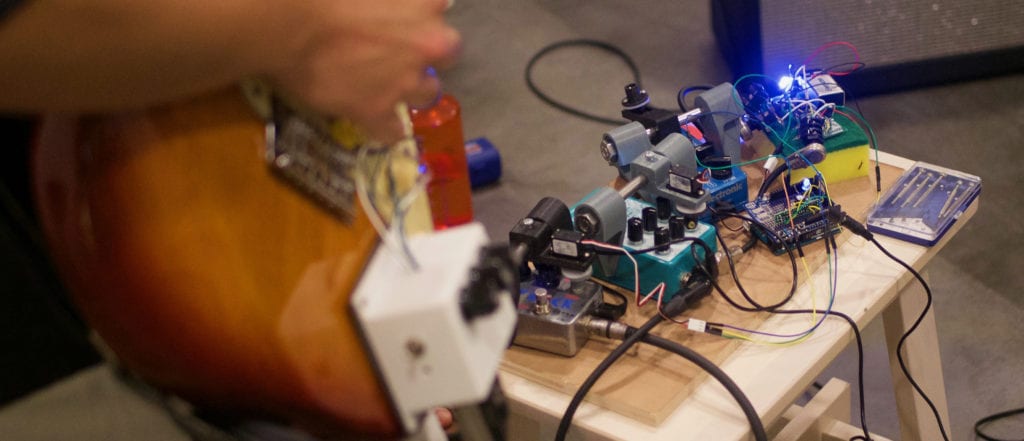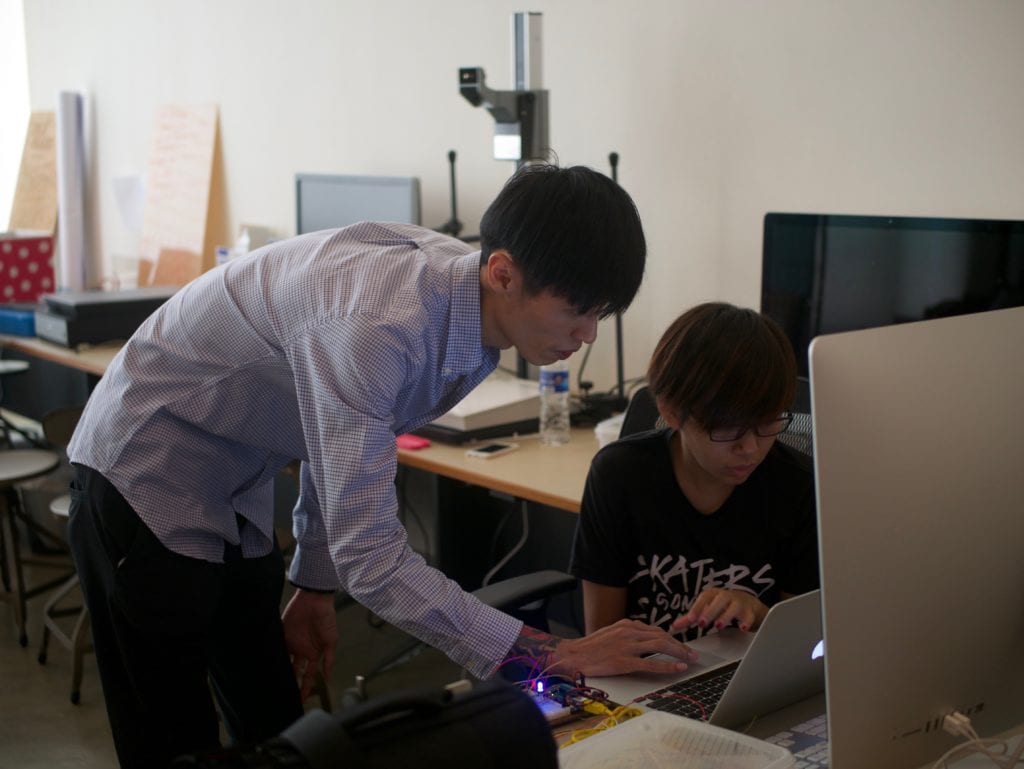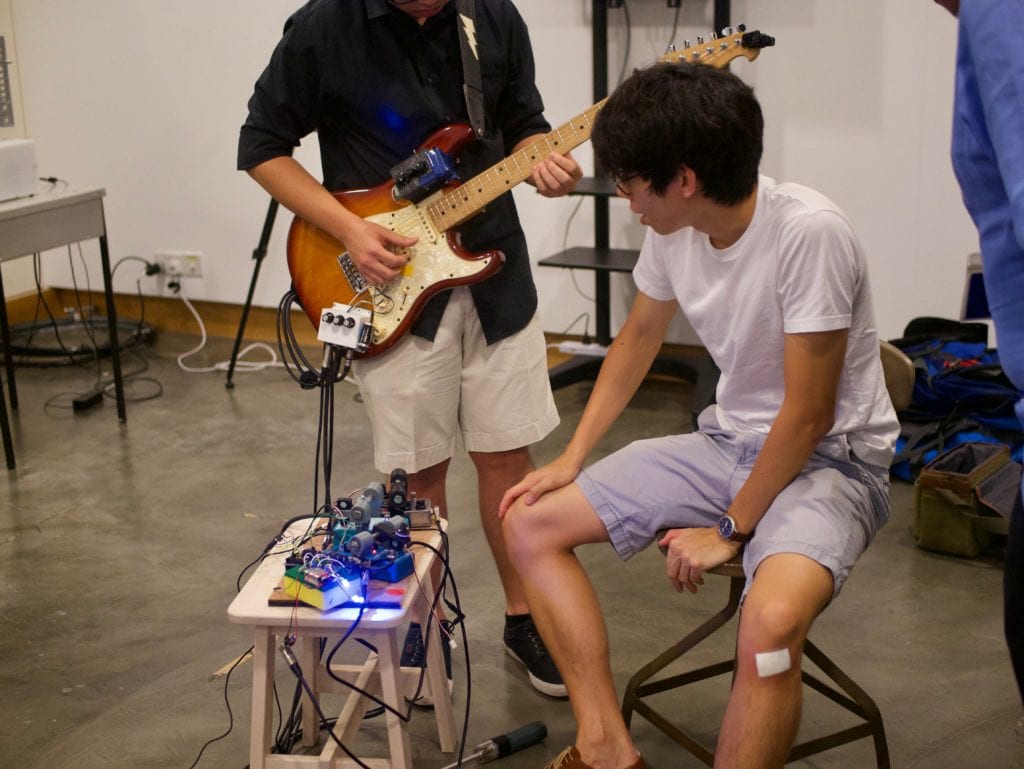Course on interface design for time-based art forms integrates technical skills with new modes of artistic expression

At Yale-NUS College, with its unique curriculum emphasis on interdisciplinarity, many course offerings lie at the intersection of multiple disciplines, even spanning the arts and sciences. ‘Interface Design for Time-Based Art Forms’ is one such course and was taught by Lecturer of Humanities, Dr Jingyin (Jon) He, who specialises in Sonic Arts, in the last semester.
12 students gamely took up the course, where they learned how to create hardware and software interfaces that enable artistic expression of ‘time-based’ art forms, such as music and dance, which have a dynamic and temporal element.
“Digital technology is an integral part of our daily life and has given birth to new artistic practices,” said Dr He. “I want students to go beyond their wildest imagination of what current technology can achieve and try to transfer the experience in their mind to the physical world.”

Dr He (above) himself is a performing musician in the realm of experimental sound and integrated media. He often uses music as a starting point to discuss more general points about expression of various art forms using technology.
Students worked in groups on a final project throughout the semester. “The class was very flexible and along the way, we were able to acquire skills we needed in the designing of the project,” said Yuling Lee (Class of 2020), one of the 12 students who took the class.
Held twice a week, the class comprised both theory and practical components. Once a week, students learned programming languages. Specifically, they dabbled with the programming language used to control Arduino microcontrollers, as well as Pure Data, a visual programming language. Free and open source with plenty of online resources, students were also able to pursue the learning of these programming languages further, even outside of class. They also learned about sensors, 3D-modelling and soldering circuits.
In the second class of each week, students worked on their projects in the Yale-NUS Fabrication Studio. The Fabrication Studio is the College’s maker space equipped with state-of-the-art equipment such as a 3D-printer, a computer numerical control (CNC) machine, and a laser cutter.
“The scope of the class is huge,” said Jaime Koh (Class of 2019), another student in the course. “Each topic is often complex enough to warrant a course of its own, but Dr He touched on a wide range in order to show students all the possible approaches, since there is a plethora of tools you can choose from to achieve what you set out to,” he explained.
The course fostered both creativity for artistic expression and the technical skills to implement it in physical form. Dr He believes all students can take something away from this course. For students with an affinity towards the arts and humanities, this course was an avenue for them to explore the use of technology their artistic applications. For those who lean towards the realm of computer scientists and engineers, they were able to experience the finesse and nuance required in using technology for artistic expression.
“This opens up their perspective to considering approaches and will perhaps bring insights into their own practices,” he said.
When Jaime joined the College, he was planning to pursue a major within the Humanities Division. However, he began seriously considering a major in Mathematical, Computational and Statistical Sciences (MCS), after taking a course on data analysis and visualisation in the previous semester. Dr He’s class helped him to further confirm his interest in MCS.
“This class allowed me to witness the intersection of my art form, music, and coding,” said Jaime, who has been playing guitar since he was 14. Jaime’s group worked on building an electric guitar with independent pickups. In a regular guitar, all six guitar strings are detected by a single pickup, producing a single output. The group’s creation, on the other hand, had three separate outputs, with two strings per pickup. The signal is transmitted wirelessly, using a complex combination of servo motors and Arduino microcontrollers.

“This allows us to individually apply effects to pairs of strings at once,” explained Jaime. “I can have a delay on my two highest strings and a heavy distortion on another pair.”
Speaking in relation to the broader context of a liberal arts college like Yale-NUS, Dr He explained the value of the course, “Encouraging the development of these innovative perspectives to the same problem provides a different outlet for students to experience, learn, and cultivate both hard and soft skillsets.”
Students presented their projects at an evening showcase on 6 April the Yale-NUS College arts studio, followed by performances by two mechatronic musical instrument specialists from New Zealand.





